BTSE Review

BTSE Exchange Review
BTSE Exchange is a cryptocurrency exchange registered in the British Virgin Islands. It has been active since September 2018.
This exchange is a so called derivatives exchange, meaning that they focus on derivatives trading. A derivative is an instrument priced based on the value of another asset (normally stocks, bonds, commodities etc). In the cryptocurrency world, derivatives accordingly derive its values from the prices of specific cryptocurrencies. You can engage in derivatives trading connected to the following cryptos here: BTC, ETH, LTC, USDT, TUSD and USDC.
As a few of the main advantages with the platform, BTSE Exchange mentions that it has almost no down-time at all, that it has a trading engine that can execute more than 1 million order requests per second and that 99.9% of all the funds held at the platform is in cold storage. These advantages are all top quality and impressive.
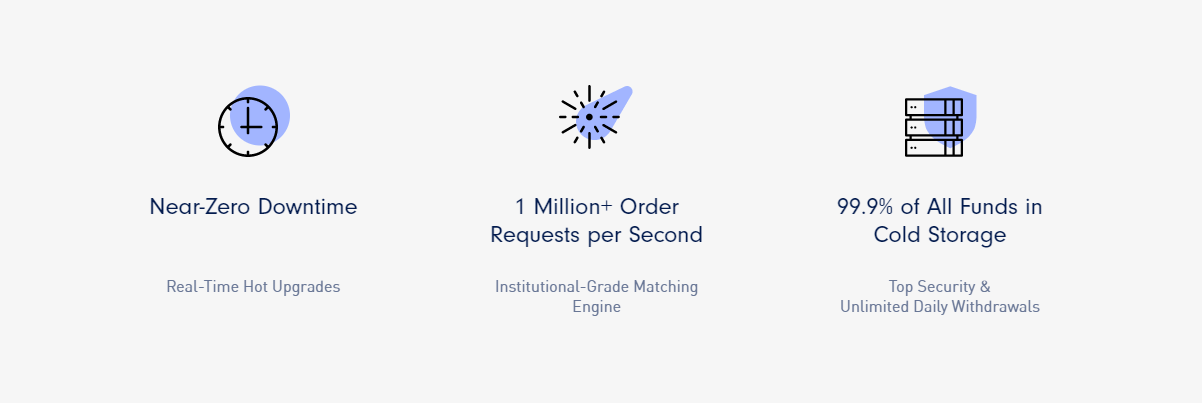
BTSE Exchange Mobile Support
Most crypto traders feel that desktop give the best conditions for their trading. The computer has a bigger screen, and on bigger screens, more of the crucial information that most traders base their trading decisions on can be viewed at the same time. The trading chart will also be easier to display. However, not all crypto investors require desktops for their trading. Some prefer to do their crypto trading via their mobile phone. If you are one of those traders, you’ll be happy to learn that BTSE Exchange’s trading platform is also mobile compatible.
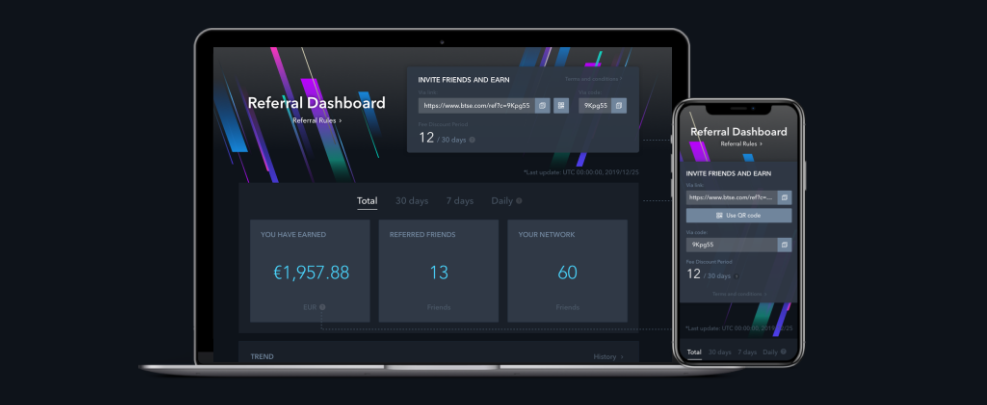
Leveraged Trading
BTSE Exchange also offers leveraged trading to its users. They offer both perpetuals (i.e. futures without expiry dates) and futures with expiry dates. The maximum leverage level for their perpetuals and non-perpetuals is 100x (i.e. onehundred times the relevant amount).
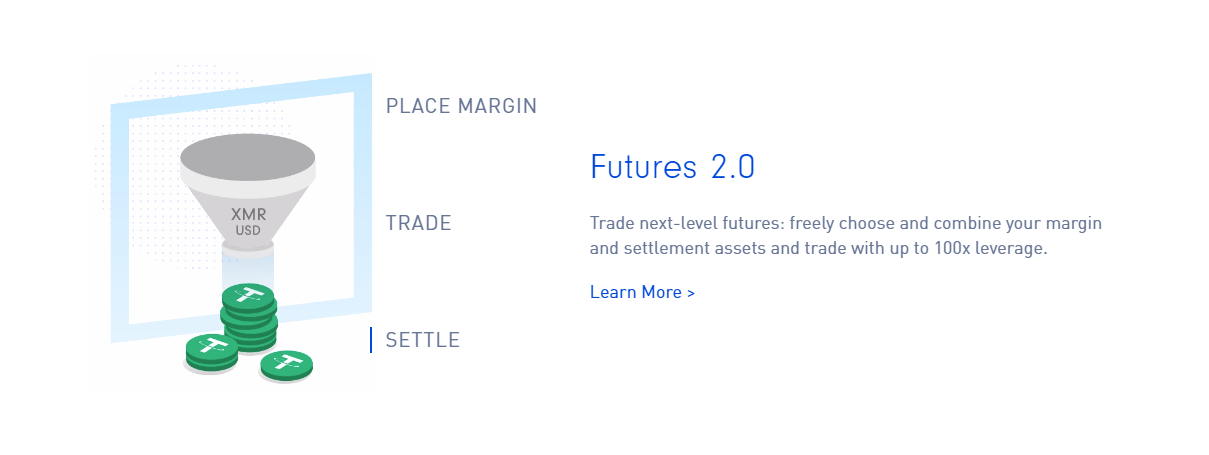
A word of caution might be useful for someone contemplating leveraged trading. Leveraged trading can lead to massive returns but – on the contrary – also to equally massive losses.
For instance, let’s say that you have 100 USD in your trading account and you bet this amount on BTC going long (i.e., going up in value). If BTC then increases in value with 10%, you would have earned 10 USD. If you had used 100x leverage, your initial 100 USD position becomes a 10,000 USD position so you instead earn an extra 1,000 USD (990 USD more than if you had not leveraged your deal). However, the more leverage you use, the smaller the distance to your liquidation price becomes. This means that if the price of BTC moves in the opposite direction (goes down for this example), then it only needs to go down a very small percentage for you to lose the entire 100 USD you started with. Again, the more leverage you use, the smaller the opposite price movement needs to be for you to lose your investment. So, as you might imagine, the balance between risk and reward in leveraged deals is quite fine-tuned (there are no risk free profits).
BTSE Exchange Trading View
Every trading platform has a trading view. The trading view is the part of the exchange’s website where you can see the price chart of a certain cryptocurrency and what its current price is. There are normally also buy and sell boxes, where you can place orders with respect to the relevant crypto, and, at most platforms, you will also be able to see the order history (i.e., previous transactions involving the relevant crypto). Everything in the same view on your desktop. There are of course also variations to what we have now described. This is the trading view at BTSE Exchange:
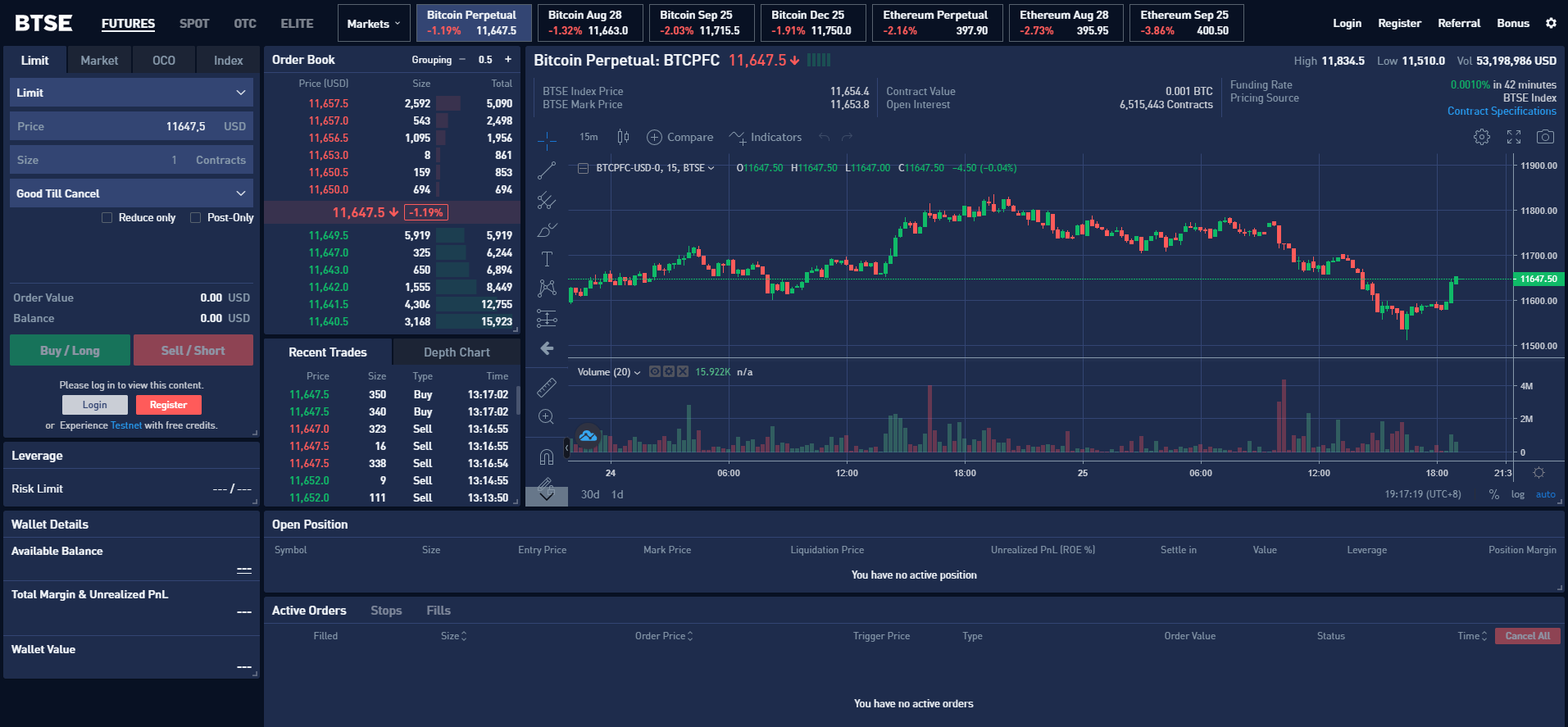
It is up to you – and only you – to decide if the above trading view is suitable to you. Finally, there are usually many different ways in which you can change the settings to tailor the trading view after your very own preferences.
OTC-desk
Let’s say that you hold a very large amount of a certain cryptocurrency. You want to sell that amount. Should you do that on a regular trading platform like everyone else? Maybe not. One of many reasons for executing large trades outside of the normal market place is that large trades may affect the market price of the relevant crypto. Another reason, which is connected to the foregoing, is that the order book might be too thin to execute the relevant trade. A solution to these problems is what we call OTC-trading (Over The Counter).
BTSE Exchange offers OTC-trading, which might be helpful to all the “whales” out there (and maybe also to all the “dolphins”).
BTSE Exchange Fees
BTSE Exchange Trading fees
Every time you place an order, the exchange charges you a trading fee. The trading fee is normally a percentage of the value of the trade order. Many exchanges divide between takers and makers. Takers are the one who “take” an existing order from the order book. Makers are the ones who add orders to the order book, thereby making liquidity at the platform.
This platform charges takers 0.12% per trade for takers, and 0.10% per trade for makers. These taker and maker fees are both below both the old and the new global industry averages for centralized exchanges. Industry averages have historically been around 0.20-0.25% but we now see new industry averages emerging around 0.10%-0.15%. According to the latest empirical study on the subject, the industry average spot trading taker fees were 0.217% and the industry average spot trading maker fees were 0.164%.
With respect to contracts trading fee, takers pay 0.04%. But the contracts trading taker fees are not even BTSE Exchange’s strongest edge. At this platform, makers get paid to trade. BTSE Exchanges contract trading maker fees are -0.01%. Naturally, this is a great deal for the makers in the contract trades at this exchange. We are really impressed by it. There are only a dozen other exchanges in the world that have negative maker fees.
Compared to the contracts trading industry average fees, the fees charged by BTSE Exchange are far below average. The contracts trading industry averages are 0.064% for takers and 0.014% for makers.
BTSE Exchange also offers trading fee discounts to customers who achieve certain trading volumes, or hold a larger number of BTSE-tokens (the exchanges native tokens). Here are the available trading fee discounts for spot trading (as of 30 September 2021):

And here are the available trading fee discounts for contracts trading (as of 30 September 2021):
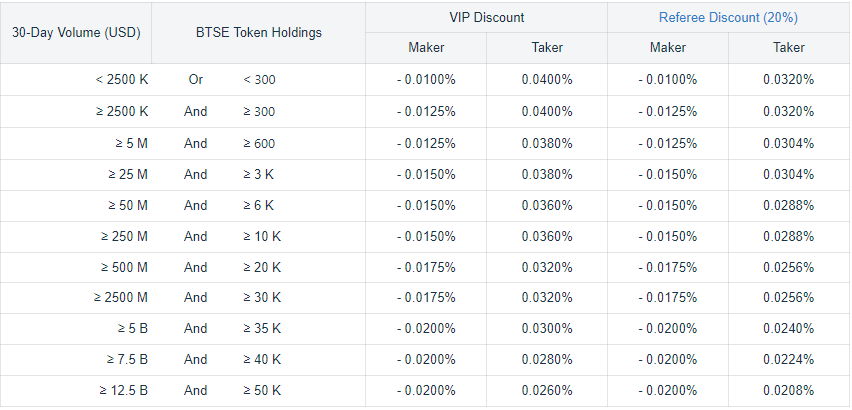
BTSE Exchange Withdrawal fees
BTSE Exchange charges a withdrawal fee of 0.0005 BTC per BTC-withdrawal. This fee is just below the industry average. The current global industry average is slightly above 0.0006 BTC per BTC-withdrawal so a fairly decent offering by BTSE Exchange in this respect.
Deposit Methods and US-investors
Deposit Methods
In addition to depositing cryptocurrency to the platform, BTSE Exchange also lets you deposit fiat currency, through both wire transfer and credit or debit card. Accordingly, this platform qualifies as an “entry-level exchange”, making it an exchange where new crypto investors can start their journey into the exciting crypto world.
US-investors
Why do so many exchanges not allow US citizens to open accounts with them? The answer has only three letters. S, E and C (the Securities Exchange Commission). The reason the SEC is so scary is because the US does not allow foreign companies to solicit US investors, unless those foreign companies are also registered in the US (with the SEC). If foreign companies solicit US investors anyway, the SEC can sue them. There are many examples of when the SEC has sued crypto exchanges, one of which being when they sued EtherDelta for operating an unregistered exchange. Another example was when they sued Bitfinex and claimed that the stablecoin Tether (USDT) was misleading investors. It is very likely that more cases will follow.
It is unclear whether BTSE Exchange permits US investors or not. We have read their Terms and Conditions and have not found an explicit prohibition of US investors. We urge any US investors to form their own opinion on the permissibility of their trading at BTSE Exchange though.


